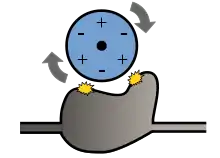Adiabatic quantum motor
An adiabatic quantum motor is a mechanical device, typically nanometric, driven by a flux of quantum particles and able to perform cyclic motions. The adjective “adiabatic” in this context refers to the limit when the dynamics of the mechanical degrees of freedom is slow compared with the dwell time of the particles passing through the device. In this regime, it is commonly assumed that the mechanical degrees of freedom behave classically. This class of devices works essentially as quantum pumps operated in reverse. While in a quantum pump, the periodic movement of some parameters pumps quantum particles from one reservoir to another, in a quantum motor a DC current of particles induces the cyclic motion of the device. One key feature of these motors is that quantum interferences can be used to increase their efficiency by enhancing the reflection coefficient of the scattered particles. Although there are several proposals for the realization of adiabatic quantum motors, none of them have been verified experimentally. [1] [2] [3] [4] [5] [6] [7] [8] [9]

Adiabatic quantum motors
References
- Bustos-Marún, Raúl; Refael, Gil; von Oppen, Felix (2013-08-05). "Adiabatic Quantum Motors". Physical Review Letters. American Physical Society (APS). 111 (6): 060802. arXiv:1304.4969. doi:10.1103/physrevlett.111.060802. ISSN 0031-9007.
- Fernández-Alcázar, Lucas J.; Bustos-Marún, Raúl A.; Pastawski, Horacio M. (2015-08-05). "Decoherence in current induced forces: Application to adiabatic quantum motors". Physical Review B. American Physical Society (APS). 92 (7): 075406. arXiv:1506.07035. doi:10.1103/physrevb.92.075406. ISSN 1098-0121.
- Arrachea, Liliana; von Oppen, Felix (2015). "Nanomagnet coupled to quantum spin Hall edge: An adiabatic quantum motor". Physica E: Low-dimensional Systems and Nanostructures. Elsevier BV. 74: 596–602. arXiv:1507.06505. doi:10.1016/j.physe.2015.08.031. ISSN 1386-9477.
- Ludovico, María Florencia; Battista, Francesca; von Oppen, Felix; Arrachea, Liliana (2016-02-18). "Adiabatic response and quantum thermoelectrics for ac-driven quantum systems". Physical Review B. American Physical Society (APS). 93 (7): 075136. arXiv:1506.08617. doi:10.1103/physrevb.93.075136. ISSN 2469-9950.
- Fernández-Alcázar, Lucas J.; Pastawski, Horacio M.; Bustos-Marún, Raúl A. (2017-04-07). "Dynamics and decoherence in nonideal Thouless quantum motors". Physical Review B. American Physical Society (APS). 95 (15): 155410. arXiv:1612.09166. doi:10.1103/physrevb.95.155410. ISSN 2469-9950.
- Calvo, Hernán L.; Ribetto, Federico D.; Bustos-Marún, Raúl A. (2017-10-23). "Real-time diagrammatic approach to current-induced forces: Application to quantum-dot based nanomotors". Physical Review B. American Physical Society (APS). 96 (16): 165309. arXiv:1710.04331. doi:10.1103/physrevb.96.165309. ISSN 2469-9950.
- Ludovico, María Florencia; Capone, Massimo (2018-12-05). "Enhanced performance of a quantum-dot-based nanomotor due to Coulomb interactions". Physical Review B. American Physical Society (APS). 98 (23): 235409. arXiv:1808.10780. doi:10.1103/physrevb.98.235409. ISSN 2469-9950.
- Bruch, Anton; Kusminskiy, Silvia Viola; Refael, Gil; von Oppen, Felix (2018-05-09). "Interacting adiabatic quantum motor". Physical Review B. American Physical Society (APS). 97 (19): 195411. arXiv:1712.04952. doi:10.1103/physrevb.97.195411. ISSN 2469-9950.
- Fernández-Alcázar, Lucas J.; Pastawski, Horacio M.; Bustos-Marún, Raúl A. (2019-01-02). "Nonequilibrium current-induced forces caused by quantum localization: Anderson adiabatic quantum motors". Physical Review B. American Physical Society (APS). 99 (4): 045403. arXiv:1810.00220. doi:10.1103/physrevb.99.045403. ISSN 2469-9950.
External links
 Media related to Adiabatic quantum motor at Wikimedia Commons
Media related to Adiabatic quantum motor at Wikimedia Commons